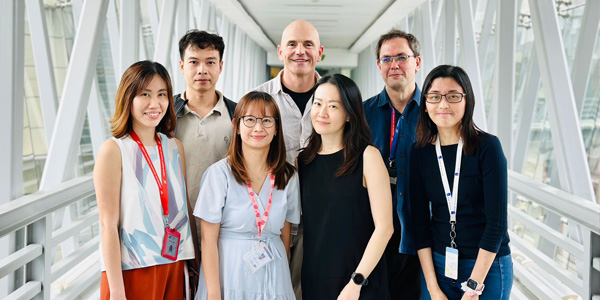News
IMCB spin-off Albatroz takes flight

The scientists behind Albatroz’s technology
From left to right: Eve NGOH (SIgN, Dr. Cheng-I WANG's lab), Dr. Anh Tuan NGUYEN (IMCB), Felicia Pei Ling TAY (IMCB), Dr. Frederic BARD (formerly IMCB), Jasmine THAM Keit Min (IMCB), Dr. Xavier LE GUEZENNEC (IMCB), Dr. Joanne Zhi Hui CHIA (IMCB).
IMCB alumnus Frederic Bard is making waves in Singapore’s biotherapeutics space as scientific founder and CEO of startup Albatroz Therapeutics, which secured $3M USD in seed funding earlier this year.
Fred, as his colleagues call him, kickstarted this journey at IMCB, where he worked on the groundbreaking technology behind Albatroz for more than a decade. It was here where he first characterised the role of the GalNac-T Activation (GALA) glycosylation pathway in driving extracellular matrix (ECM) degradation – a process that spurs tumour growth and spread, as well as arthritis progression. This discovery led to the uncovering of a new therapeutic target, which Fred and his team found a way to attack using antibodies, potentially yielding new treatments for cancer and arthritis.
Since starting Albatroz in 2020, Fred has continued to bring his work to new heights. In this interview, Fred shares his insights as a scientist-entrepreneur and offers words of encouragement for young scientists aspiring to do the same.
What motivated you to start Albatroz Therapeutics?
I was motivated by the desire to translate a body of scientific work into a therapeutic product. With the initial positive results of our research grade antibodies, we also saw an opportunity.
How did your research at IMCB set the foundation for Albatroz Therapeutics?
Long years of research at IMCB set the foundation for Albatroz. Our initial publication describing the basis of the GALA pathway was in 2010, by a talented postdoc named David Gill. Afterwards, we had several publications with Joanne Chia, Anh Tuan Nguyen and others to show that GALA drives the growth of solid tumours by controlling protein glycosylation. Finally, Manon Ros, with the help from several people in the group, identified Calnexin as a substrate of GALA that is translocated to the cell surface of cancer cells specifically.
Could you share with us a recent development at Albatroz Therapeutics you are most excited about?
Our recent results indicate that Calnexin could be a good target for antibody drug conjugates (ADCs), which are typically made up of a small molecule drug bound to a monoclonal antibody that guides it to specific sites. ADCs are an exciting modality for cancer treatment, often described as "biological missiles” against cancer.
What advice do you have for scientists who are aspiring entrepreneurs?
Build up a solid scientific foundation first. Take your machete, step out of the beaten path and enter the unexplored jungle.
A*STAR celebrates International Women's Day

From groundbreaking discoveries to cutting-edge research, our researchers are empowering the next generation of female science, technology, engineering and mathematics (STEM) leaders.
Get inspired by our #WomeninSTEM
.png?sfvrsn=c3edc68e_6)